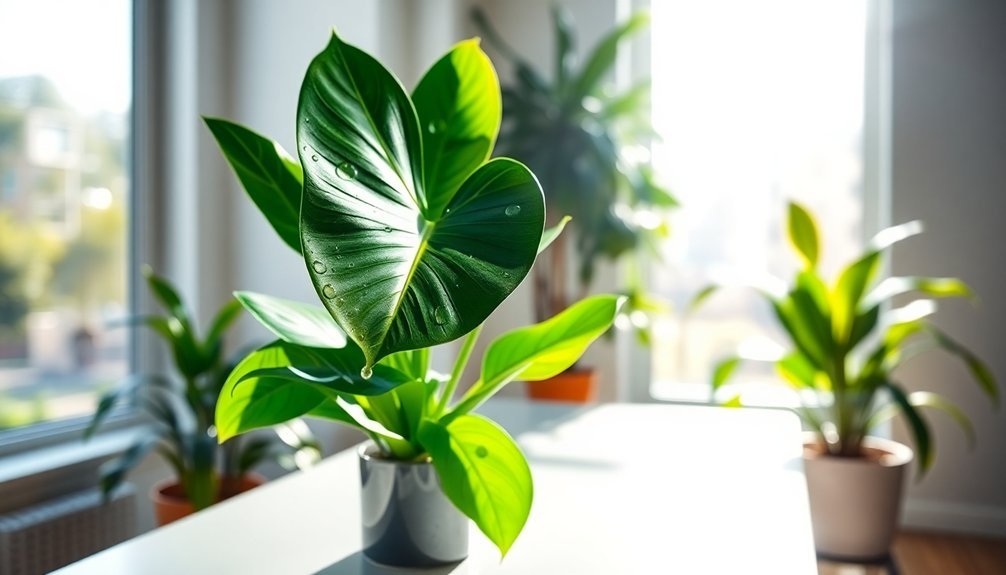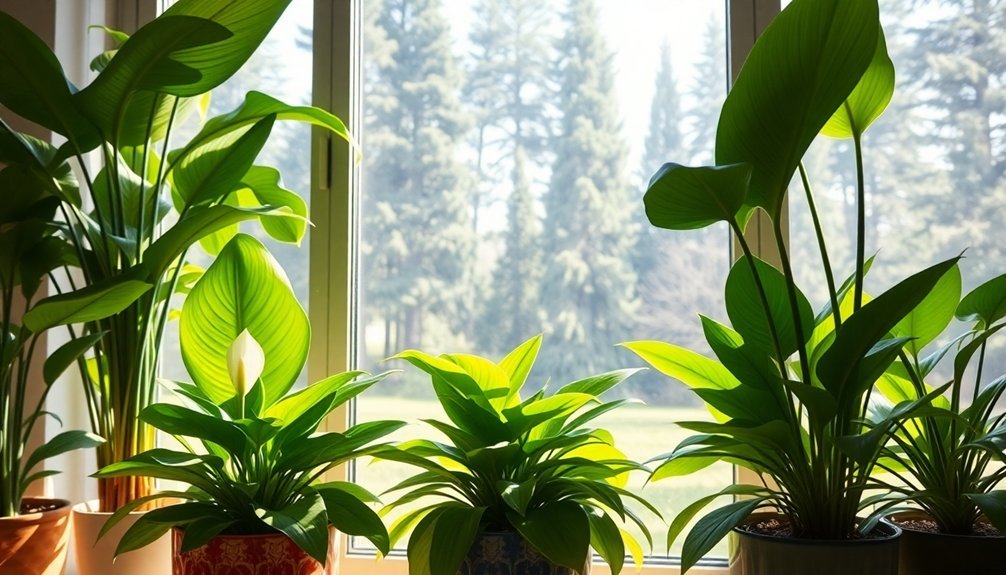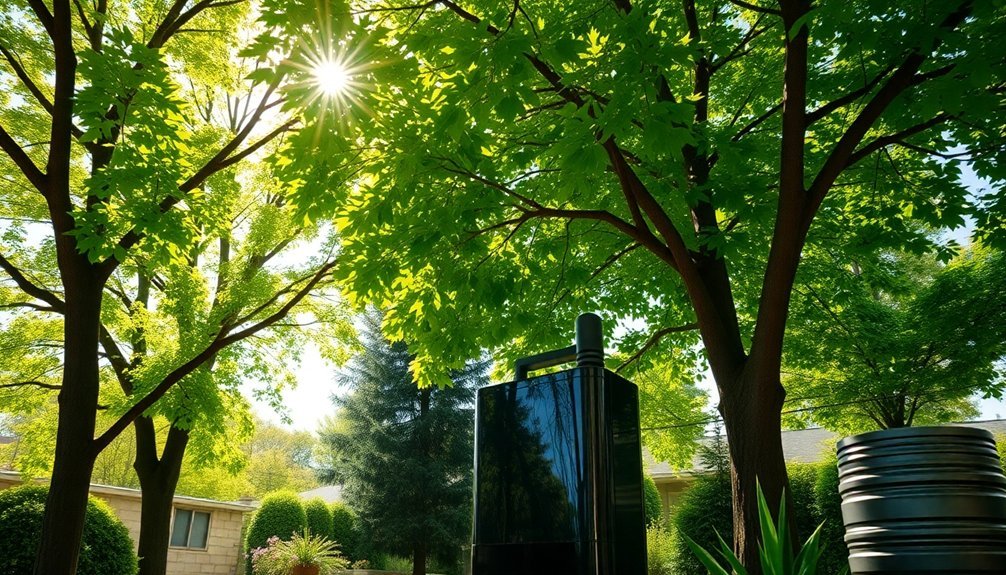Several indoor trees can effectively purify your home's air from harmful chemical pollutants. You'll find the bamboo palm excellent at removing formaldehyde and benzene, while the dracaena family tackles multiple volatile organic compounds. For smaller spaces, consider peace lilies or snake plants, which pack powerful air-cleaning abilities into compact forms. Position these natural air purifiers near pollution sources and clean their leaves regularly to maximize their detoxifying potential. Understanding each tree's specific strengths will help you create the ideal air-cleaning environment.
Understanding Indoor Air Pollutants and VOCs

What makes indoor air quality such a critical health concern? Your home contains various pollutants that can affect your health, from biological contaminants like mold and pet dander to toxic gases like carbon monoxide and nitrogen dioxide. Many of these pollutants come from everyday sources you mightn't suspect.
Volatile Organic Compounds (VOCs) are particularly concerning chemicals that evaporate at room temperature. You'll find them in common items like furniture, flooring, cleaning supplies, and personal care products. These hazardous substances can enter homes through vapor intrusion from foundation cracks.
When these compounds mix with nitrogen oxides, especially in polluted cities, they can create ground-level ozone. Poor ventilation makes matters worse by allowing these pollutants to accumulate indoors.
Without proper air exchange, your exposure to these harmful substances increases, potentially leading to respiratory issues and other health problems.
Best Indoor Trees for Chemical Pollutant Removal
When choosing indoor trees to combat chemical pollutants, you'll want to take into account both the size of your space and the tree's mature height, as larger specimens typically remove more toxins.
You can maximize your tree's air-purifying abilities by maintaining proper light exposure, consistent watering schedules, and regular pruning to encourage healthy growth. Recent studies show that indoor plants can remove over 40% of pollutants within an eight-hour period.
The most effective chemical-fighting indoor tree species include the Bamboo Palm, which targets formaldehyde and benzene, and the Dracaena family, which excels at removing multiple volatile organic compounds from your indoor air.
Indoor Tree Size Matters
Selecting the right-sized indoor tree is essential for effective chemical pollutant removal in your living space. You'll find options ranging from small to large, each targeting specific pollutants.
For smaller spaces, consider the compact bamboo palm or peace lily, which tackle formaldehyde and benzene. Medium-sized choices like the Boston fern and weeping fig work well in roomier areas while removing multiple pollutants. The areca palm requires loam for optimal growth and toxin removal capabilities.
If you've got ample space, the dwarf date palm or golden pothos can make powerful air-cleaning statements.
Remember to match your tree's size with your available light and humidity conditions. While some trees like the snake plant and Chinese evergreen tolerate low light, most prefer bright, indirect sunlight.
Consider toxicity too – keep spiny plants like the dwarf date palm away from children's areas.
Purifying Tree Care Tips
To maximize your indoor trees' air-purifying abilities, proper care and placement are essential. Position your trees away from heat vents and near sources of indoor pollution, like new furniture or carpets. Maintain temperatures between 65-75°F and guarantee adequate airflow around each tree to enhance their pollutant-removing capabilities.
- Choose bright, indirect light for trees like Rubber Plants and Dracaena, or place them near east-facing windows for prime exposure.
- Water moderately based on each species' needs – Snake Plants and Aloe Vera need less frequent watering than Peace Lilies.
- Monitor soil moisture carefully, ensuring it's neither waterlogged nor completely dry.
- Space trees strategically throughout your home, especially in poorly ventilated areas where pollutants tend to accumulate.
Regular maintenance and proper positioning will help your trees effectively combat indoor air pollution.
Top Chemical-Fighting Species
Several powerful air-purifying trees stand out for their ability to combat indoor chemical pollutants.
The Peace Lily excels at removing multiple toxins like formaldehyde, benzene, and ammonia while adding elegant white blooms to your space.
You'll find the Dracaena equally effective, targeting five major pollutants and growing impressively tall in bright, indirect light.
For low-maintenance options, consider the Snake Plant or Golden Pothos.
They'll thrive with minimal care while removing formaldehyde, benzene, and other harmful chemicals.
If you're seeking a tropical touch, the Areca Palm or Bamboo Palm both clean multiple pollutants while adding lush greenery.
The Rubber Plant, with its striking dark leaves, specifically targets formaldehyde and can reach impressive heights of up to 8 feet.
How Trees Filter Indoor Air Contaminants

While outdoor air pollution often takes center stage, indoor trees can effectively filter harmful contaminants from your home's air. Through photosynthesis, trees convert CO2 into oxygen while absorbing other pollutant gases through tiny pores in their leaves called stomata. These gases are then broken down and either used for growth or stored within the tree's tissues.
Your indoor trees can help purify your air in several ways:
- They'll trap particulate matter on their leaf surfaces, preventing these particles from circulating in your home.
- You'll get more efficient filtration from trees with rough, broad leaves compared to smooth-leaved varieties.
- Mature trees work harder at cleaning your air due to their larger leaf coverage.
- Pine trees can capture twice as many particles as leafy trees, making them excellent indoor air purifiers.
Setting Up Your Indoor Tree Air Purification System
Place your air-purifying tree in a spot with good air circulation while ensuring it's away from direct heating or cooling vents that could stress the plant.
You'll need to match your tree's specific light requirements, whether it's bright indirect light for a Rubber Plant or lower light conditions for a Snake Plant, to maximize its air-cleaning potential.
Follow a consistent watering schedule based on your tree's needs, checking the soil moisture regularly and adjusting for seasonal changes to maintain ideal growing conditions.
Tree Placement For Success
Successfully setting up an indoor tree air purification system requires careful consideration of both placement and design elements.
You'll want to maximize air purification effectiveness by strategically positioning your trees and using active systems where possible.
- Place trees in each room, focusing on areas where you spend the most time.
- Position outdoor trees near pollution sources like busy streets to create natural barriers.
- Use fan-assisted systems with activated carbon beds beneath potting soil for enhanced filtration.
- Consider combining indoor and outdoor plants for ideal air quality improvement.
For best results, integrate both passive and active systems.
You can boost effectiveness by using fans to circulate air through activated carbon beds, which can greatly improve filtration within two hours.
If you're dealing with specific pollutant sources, place your trees between these sources and your living spaces.
Watering and Light Needs
Once you've positioned your air-purifying trees, maintaining them requires understanding their specific water and light requirements. Most species need regular watering, but be careful not to overwater. Use well-draining soil and clean, non-chlorinated water to protect your trees' roots from rot.
For ideal air purification, place your trees according to their light preferences. While some varieties like Aloe thrive in bright, indirect light, others such as Golden Pothos can adapt to low-light conditions. Keep your trees away from direct sunlight to prevent leaf damage.
If you're growing humidity-loving species, consider misting them regularly. Maintain temperatures between 18-24°C (64-75°F), and monitor soil moisture levels carefully. Different species have varying needs – some prefer consistently moist soil, while others do better when the soil dries between waterings.
Maintenance Tips for Maximum Air-Cleaning Benefits

To maximize a tree's air-cleaning potential, proper maintenance plays a significant role throughout its life cycle. Regular leaf cleaning is vital, as dust and particles can reduce a tree's ability to absorb pollutants effectively.
You'll want to use a damp microfiber cloth or gentle spray bottle to clean leaves, and for prickly varieties, a soft paintbrush works best.
Here's what you need to focus on for best air-purifying performance:
- Remove dead or yellowing leaves promptly to maintain overall health
- Check regularly for pests and diseases, treating issues immediately
- Clean leaves routinely, adjusting frequency based on pollution levels
- Prune strategically to maximize leaf surface area for better pollutant absorption
Remember that mature trees are more effective at cleaning air, so proper long-term care guarantees your tree reaches its full air-purifying potential.
Scientific Research on Tree VOC Absorption Rates
Recent scientific research has revealed fascinating differences in how tree species absorb volatile organic compounds (VOCs) from the air.
Studies show that conifers excel at removing gaseous pollutants, while deciduous trees are better at filtering particle-bound pollutants due to their larger leaf surface area. Larch trees, in particular, stand out for their ability to capture both types of pollutants effectively.
Scientists have discovered that trees absorb VOCs through stomata, tiny leaf openings where pollutants break down internally. The absorption rates vary based on several factors: seasonal changes, temperature, sunlight, and leaf stress levels all play essential roles.
Quantitative research indicates impressive results – in one study, residential trees removed 1,630 tons of air pollution annually, while urban street trees considerably reduced PM2.5 concentrations, benefiting millions of city dwellers.
Combining Trees With Other Air Quality Solutions

While trees alone provide significant air quality benefits, combining them with other environmental solutions creates a more powerful approach to pollution control.
You'll get the best results by integrating trees into a thorough urban planning strategy that considers air flow, energy efficiency, and stormwater management.
- Pair trees with proper street design to optimize air circulation, using lower-growing vegetation in narrow streets and taller trees in open spaces.
- Combine different tree species strategically – conifers for gaseous pollutants and broadleaved trees for particle-bound pollution.
- Plant trees near buildings to reduce energy consumption through natural cooling and shade.
- Incorporate trees into stormwater management systems to filter pollutants and reduce runoff by up to 27%.
These integrated approaches maximize the pollution-fighting potential of urban forests while creating additional environmental benefits for your community.
Frequently Asked Questions
Can Indoor Trees Absorb Electromagnetic Radiation From Electronic Devices?
No, indoor trees can't protect you from electromagnetic radiation. While plants can be harmed by EMF from electronic devices, they don't absorb or block this radiation in a way that reduces your exposure.
Do Air-Purifying Trees Attract Specific Insects More Than Regular Houseplants?
You won't notice more insects with air-purifying trees compared to regular houseplants. While outdoor varieties might attract specific pollinators, indoor specimens typically don't draw any more bugs than standard house plants.
How Do Seasonal Changes Affect Indoor Trees' Ability to Filter Pollutants?
Your indoor trees' pollutant-filtering ability drops in winter due to reduced light and photosynthesis. You'll notice better performance during warmer months, but you can maintain efficiency with consistent indoor lighting and temperature control.
Will Air-Purifying Trees Affect the Performance of HVAC Systems?
Your air-purifying trees won't harm HVAC performance if you maintain proper distance and regular cleaning. They'll actually help by reducing cooling needs, but you'll need to prevent leaves from clogging outdoor units.
Can Indoor Trees Remove Cigarette Smoke Odors Permanently From Furniture and Carpets?
You can't rely on indoor trees alone to permanently remove cigarette smoke from furniture and carpets. They'll help filter air pollutants but won't eliminate embedded smoke residue in your furnishings and fibers.
In Summary
You've now got the knowledge to turn your home into a cleaner, healthier space using nature's air purifiers. By selecting the right trees, placing them strategically, and maintaining them properly, you'll reduce harmful VOCs and chemical pollutants in your indoor air. Remember to combine your indoor trees with other air quality measures for the best results. Start small, monitor their effectiveness, and expand your indoor forest gradually.
References
- https://www.usda.gov/about-usda/news/blog/trees-can-do-dirty-work-waste-cleanup
- https://treesunlimitednj.com/blog/the-best-air-purifying-trees-and-plants/
- https://edu.rsc.org/feature/how-do-trees-clean-our-air/4010864.article
- https://www.greenamerica.org/your-home-detoxed/planting-seeds-clean-air
- https://www.green.earth/blog/breathe-easy-how-trees-are-natures-air-cleaning-machines
- https://www.epa.gov/indoor-air-quality-iaq/indoor-pollutants-and-sources
- https://www.sciencejournalforkids.org/articles/what-can-trees-tell-us-about-the-air-we-breathe-at-home/
- https://www.niehs.nih.gov/health/topics/agents/indoor-air
- https://www.epa.gov/indoor-air-quality-iaq/introduction-indoor-air-quality
- https://www.the-independent.com/news/science/office-plants-air-pollution-removal-b2352071.html





Leave a Reply